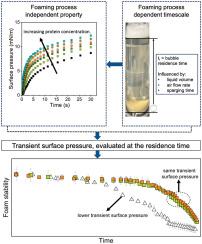是什么决定了稀释蛋白质溶液在喷射系统中的泡沫稳定性?
IF 11
1区 农林科学
Q1 CHEMISTRY, APPLIED
引用次数: 0
摘要
食品、制药和化妆品行业对可持续功能性配料的需求日益增长,这提高了人们对植物蛋白作为发泡剂的兴趣。然而,关于瞬态材料特性如何受发泡条件影响而影响泡沫稳定性的知识仍然存在空白。本研究采用气体喷射法研究了稀释豌豆蛋白溶液(0.1-1 wt%)的泡沫形成和稳定性。我们研究了蛋白质特性(包括体积粘度、吸附动力学)和发泡条件(如喷射流速、初始液体体积和喷射时间)的影响。通过将泡沫半衰期(t1/2)与不同时间尺度下的表面压力相关联,我们观察到,在广泛的发泡处理参数(流速 0.2-0.4 L/min、液体体积 30-150 mL、喷射时间 5-10 s)和蛋白质浓度范围内,停留时间下的瞬态表面压力(πr)与 t1/2(R2 = 0.94)密切相关,这与平衡表面压力或喷射时间下的表面压力不同。这凸显了 πr 在控制稀释蛋白质溶液泡沫稳定性方面的重要性,因为它与初始气泡大小直接相关。我们的研究结果揭示了受发泡加工参数影响的瞬态表面特性是如何影响泡沫稳定性的。这些发现有助于人们更广泛地了解植物蛋白的功能,并为提高其在食品和非食品应用中的使用提供了潜在的策略。本文章由计算机程序翻译,如有差异,请以英文原文为准。

What determines the foam stability of dilute protein solutions in sparging systems?
The growing demand for sustainable and functional ingredients in the food, pharmaceutical, and cosmetic industries has heightened interest in plant proteins as foaming agents. However, a knowledge gap persists regarding how transient material properties, influenced by foaming conditions, impact foam stability. This study investigates foam formation and stability of dilute pea protein solutions (0.1–1 wt%) using a gas sparging method. We examine the impact of protein properties, including bulk viscosity, adsorption kinetics, and foaming conditions like sparging flow rate, initial liquid volume, and sparging time. By correlating foam half-life (t1/2) with surface pressure at various time scales, we observed that transient surface pressure at residence time (πr) strongly correlated with t1/2 (R2 = 0.94) over a wide range of foaming processing parameters (flow rate of 0.2–0.4 L/min, liquid volume of 30–150 mL, and sparging time of 5–10 s) and protein concentrations, unlike equilibrium surface pressure or surface pressure at sparging time. This highlights the significance of πr, as it directly relates to initial bubble size, in controlling foam stability for dilute protein solutions. Our results reveal key insights into how transient surface properties, influenced by foaming processing parameters, govern foam stability. These findings contribute to the broader understanding of plant protein functionality and offer potential strategies for enhancing their use in both food and non-food applications.
求助全文
通过发布文献求助,成功后即可免费获取论文全文。
去求助
来源期刊

Food Hydrocolloids
工程技术-食品科技
CiteScore
19.90
自引率
14.00%
发文量
871
审稿时长
37 days
期刊介绍:
Food Hydrocolloids publishes original and innovative research focused on the characterization, functional properties, and applications of hydrocolloid materials used in food products. These hydrocolloids, defined as polysaccharides and proteins of commercial importance, are added to control aspects such as texture, stability, rheology, and sensory properties. The research's primary emphasis should be on the hydrocolloids themselves, with thorough descriptions of their source, nature, and physicochemical characteristics. Manuscripts are expected to clearly outline specific aims and objectives, include a fundamental discussion of research findings at the molecular level, and address the significance of the results. Studies on hydrocolloids in complex formulations should concentrate on their overall properties and mechanisms of action, while simple formulation development studies may not be considered for publication.
The main areas of interest are:
-Chemical and physicochemical characterisation
Thermal properties including glass transitions and conformational changes-
Rheological properties including viscosity, viscoelastic properties and gelation behaviour-
The influence on organoleptic properties-
Interfacial properties including stabilisation of dispersions, emulsions and foams-
Film forming properties with application to edible films and active packaging-
Encapsulation and controlled release of active compounds-
The influence on health including their role as dietary fibre-
Manipulation of hydrocolloid structure and functionality through chemical, biochemical and physical processes-
New hydrocolloids and hydrocolloid sources of commercial potential.
The Journal also publishes Review articles that provide an overview of the latest developments in topics of specific interest to researchers in this field of activity.
 求助内容:
求助内容: 应助结果提醒方式:
应助结果提醒方式:


